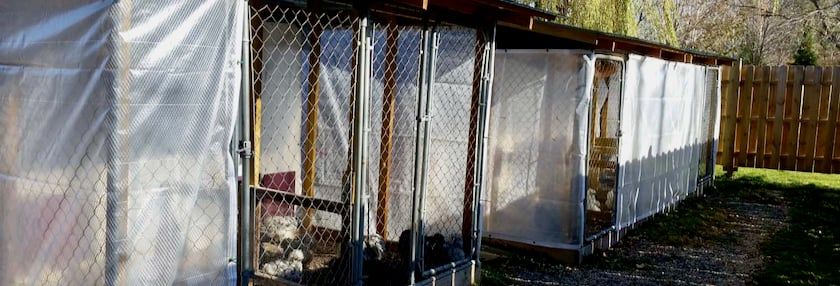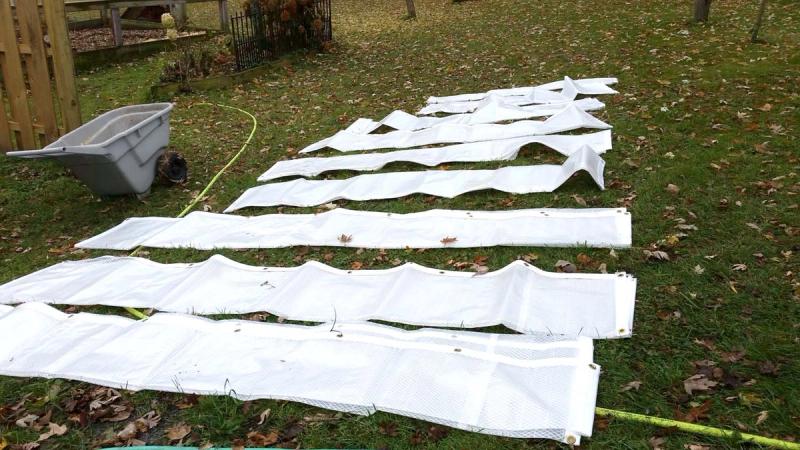Tips for Winterizing Your Chicken Run


Some wood, tarps, and bungees do the trick
In Minnesota where I live, it is colder outside, and you may find that your chickens are spending more of their time inside the coop, choosing to snuggle up where it is warmer. The problem is that chickens need fresh air and exercise. They will be hardier and healthier if they spend part of their day outside in the run.
The Silkies I breed are surprisingly hardy and ideal for cold areas. Not only do they have small walnut combs and almost nonexistent wattles, they also have feathering on their feet to help keep their legs warmer.
Silkies are tolerant of the cold but they must be protected from wet and wind.
One word: Plastics
Most chickens do not like walking in snow. Enclosing your run with plastic wrap or a tarp can help to block wind and prevent snow and rain from entering the run.
We are trying a new kind of plastic this year. Instead of using plastic that comes on a roll, we ordered clear tarps that have built in grommet holes. The tarp also has lines running through it to keep the tarp stronger and to keep it from ripping in the wind.
We placed eye hooks in the wood along the bottom of the run. The grommet holes fit into the hooks and secure the tarp. We then use ball bungee cords at the top to fasten the tarp down.
Hopefully this clear tarp can be easily taken down and put up for many years to come. We also use zip ties where needed to keep the tarps secure.
You do not need to cover the entire run. The north and west sides are the most important to cover as this will provide the best wind and snow block. You need some holes for ventilation. I leave the doors uncovered so that air can move in and out.
Boredom can be a problem in the wintertime. This can lead to behavior problems such as feather picking and egg eating. A spacious run gives chickens personal space and exercise opportunities.
You can use plywood, tarps, or even bales of hay or straw to block the wind, but clear plastic lets the sun shine through and keeps the run bright. It will warm the inside just like a greenhouse would.
In the spring, just take it down, fold it up and store it out of the way until next year.

Shelter outside of home
Alternatively, you could provide an outside shelter in your run, such as a small dog house. Use straw inside to keep your chickens warm. Straw holds more warmth because it traps warm air in its shaft.
Tip: Use some of that straw to create paths for chickens to walk on to make it warmer on their feet.
I like to provide something for them to perch on inside the run. We have pea rock in our run which can become cold on their feet in the winter. Silkies do not need very high perches. We just lay a few 2 x 4 boards down for them. They love to perch on these boards when it is cold. You could also use logs or stumps for them to stand on.
Set up a dust bathing area for them in the wintertime. You could make a new spot by purchasing some dust bathing materials and putting them in a kitty litter box.
Power them up
Provide energy treats for your birds that they can only get if they venture outside in the run. These could be sunflower seeds or cracked corn. The more time that they spend outside, the less messy the inside of your coop will be.
It is important to remember that birds can tolerate much colder temperatures than humans. You just need to keep them dry and out of drafts or wind. Do not overheat your chickens based on how you feel. I keep the windows and doors to the coops open all winter long.
If your coop is one temperature and your run another, this can lead to sickness as birds go back and forth from hot to cold temperatures.
Tags:Chicken Chatter

Acreage Life is part of the Catalyst Communications Network publication family.
















